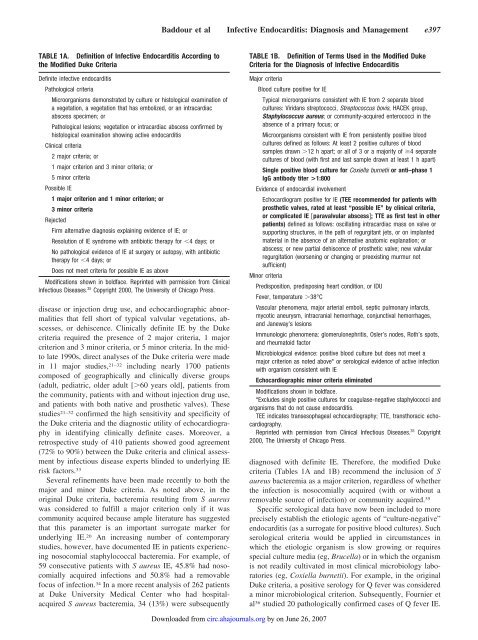Infective Endocarditis Diagnosis, Antimicrobial Therapy, and ...
Infective Endocarditis Diagnosis, Antimicrobial Therapy, and ...
Infective Endocarditis Diagnosis, Antimicrobial Therapy, and ...
Create successful ePaper yourself
Turn your PDF publications into a flip-book with our unique Google optimized e-Paper software.
Baddour et al <strong>Infective</strong> <strong>Endocarditis</strong>: <strong>Diagnosis</strong> <strong>and</strong> Management e397TABLE 1A. Definition of <strong>Infective</strong> <strong>Endocarditis</strong> According tothe Modified Duke CriteriaDefinite infective endocarditisPathological criteriaMicroorganisms demonstrated by culture or histological examination ofa vegetation, a vegetation that has embolized, or an intracardiacabscess specimen; orPathological lesions; vegetation or intracardiac abscess confirmed byhistological examination showing active endocarditisClinical criteria2 major criteria; or1 major criterion <strong>and</strong> 3 minor criteria; or5 minor criteriaPossible IE1 major criterion <strong>and</strong> 1 minor criterion; or3 minor criteriaRejectedFirm alternative diagnosis explaining evidence of IE; orResolution of IE syndrome with antibiotic therapy for 4 days; orNo pathological evidence of IE at surgery or autopsy, with antibiotictherapy for 4 days; orDoes not meet criteria for possible IE as aboveModifications shown in boldface. Reprinted with permission from ClinicalInfectious Diseases. 35 Copyright 2000, The University of Chicago Press.disease or injection drug use, <strong>and</strong> echocardiographic abnormalitiesthat fell short of typical valvular vegetations, abscesses,or dehiscence. Clinically definite IE by the Dukecriteria required the presence of 2 major criteria, 1 majorcriterion <strong>and</strong> 3 minor criteria, or 5 minor criteria. In the midtolate 1990s, direct analyses of the Duke criteria were madein 11 major studies, 21–32 including nearly 1700 patientscomposed of geographically <strong>and</strong> clinically diverse groups(adult, pediatric, older adult [60 years old], patients fromthe community, patients with <strong>and</strong> without injection drug use,<strong>and</strong> patients with both native <strong>and</strong> prosthetic valves). Thesestudies 21–32 confirmed the high sensitivity <strong>and</strong> specificity ofthe Duke criteria <strong>and</strong> the diagnostic utility of echocardiographyin identifying clinically definite cases. Moreover, aretrospective study of 410 patients showed good agreement(72% to 90%) between the Duke criteria <strong>and</strong> clinical assessmentby infectious disease experts blinded to underlying IErisk factors. 33Several refinements have been made recently to both themajor <strong>and</strong> minor Duke criteria. As noted above, in theoriginal Duke criteria, bacteremia resulting from S aureuswas considered to fulfill a major criterion only if it wascommunity acquired because ample literature has suggestedthat this parameter is an important surrogate marker forunderlying IE. 20 An increasing number of contemporarystudies, however, have documented IE in patients experiencingnosocomial staphylococcal bacteremia. For example, of59 consecutive patients with S aureus IE, 45.8% had nosocomiallyacquired infections <strong>and</strong> 50.8% had a removablefocus of infection. 34 In a more recent analysis of 262 patientsat Duke University Medical Center who had hospitalacquiredS aureus bacteremia, 34 (13%) were subsequentlyTABLE 1B. Definition of Terms Used in the Modified DukeCriteria for the <strong>Diagnosis</strong> of <strong>Infective</strong> <strong>Endocarditis</strong>Major criteriaBlood culture positive for IETypical microorganisms consistent with IE from 2 separate bloodcultures: Viridans streptococci, Streptococcus bovis, HACEK group,Staphylococcus aureus; or community-acquired enterococci in theabsence of a primary focus; orMicroorganisms consistent with IE from persistently positive bloodcultures defined as follows: At least 2 positive cultures of bloodsamples drawn 12 h apart; or all of 3 or a majority of 4 separatecultures of blood (with first <strong>and</strong> last sample drawn at least 1 h apart)Single positive blood culture for Coxiella burnetii or anti–phase 1IgG antibody titer >1:800Evidence of endocardial involvementEchocardiogram positive for IE (TEE recommended for patients withprosthetic valves, rated at least “possible IE” by clinical criteria,or complicated IE paravalvular abscess; TTE as first test in otherpatients) defined as follows: oscillating intracardiac mass on valve orsupporting structures, in the path of regurgitant jets, or on implantedmaterial in the absence of an alternative anatomic explanation; orabscess; or new partial dehiscence of prosthetic valve; new valvularregurgitation (worsening or changing or preexisting murmur notsufficient)Minor criteriaPredisposition, predisposing heart condition, or IDUFever, temperature 38°CVascular phenomena, major arterial emboli, septic pulmonary infarcts,mycotic aneurysm, intracranial hemorrhage, conjunctival hemorrhages,<strong>and</strong> Janeway’s lesionsImmunologic phenomena: glomerulonephritis, Osler’s nodes, Roth’s spots,<strong>and</strong> rheumatoid factorMicrobiological evidence: positive blood culture but does not meet amajor criterion as noted above* or serological evidence of active infectionwith organism consistent with IEEchocardiographic minor criteria eliminatedModifications shown in boldface.*Excludes single positive cultures for coagulase-negative staphylococci <strong>and</strong>organisms that do not cause endocarditis.TEE indicates transesophageal echocardiography; TTE, transthoracic echocardiography.Reprinted with permission from Clinical Infectious Diseases. 35 Copyright2000, The University of Chicago Press.diagnosed with definite IE. Therefore, the modified Dukecriteria (Tables 1A <strong>and</strong> 1B) recommend the inclusion of Saureus bacteremia as a major criterion, regardless of whetherthe infection is nosocomially acquired (with or without aremovable source of infection) or community acquired. 35Specific serological data have now been included to moreprecisely establish the etiologic agents of “culture-negative”endocarditis (as a surrogate for positive blood cultures). Suchserological criteria would be applied in circumstances inwhich the etiologic organism is slow growing or requiresspecial culture media (eg, Brucella) or in which the organismis not readily cultivated in most clinical microbiology laboratories(eg, Coxiella burnetii). For example, in the originalDuke criteria, a positive serology for Q fever was considereda minor microbiological criterion. Subsequently, Fournier etal 36 studied 20 pathologically confirmed cases of Q fever IE.Downloaded from circ.ahajournals.org by on June 26, 2007
















